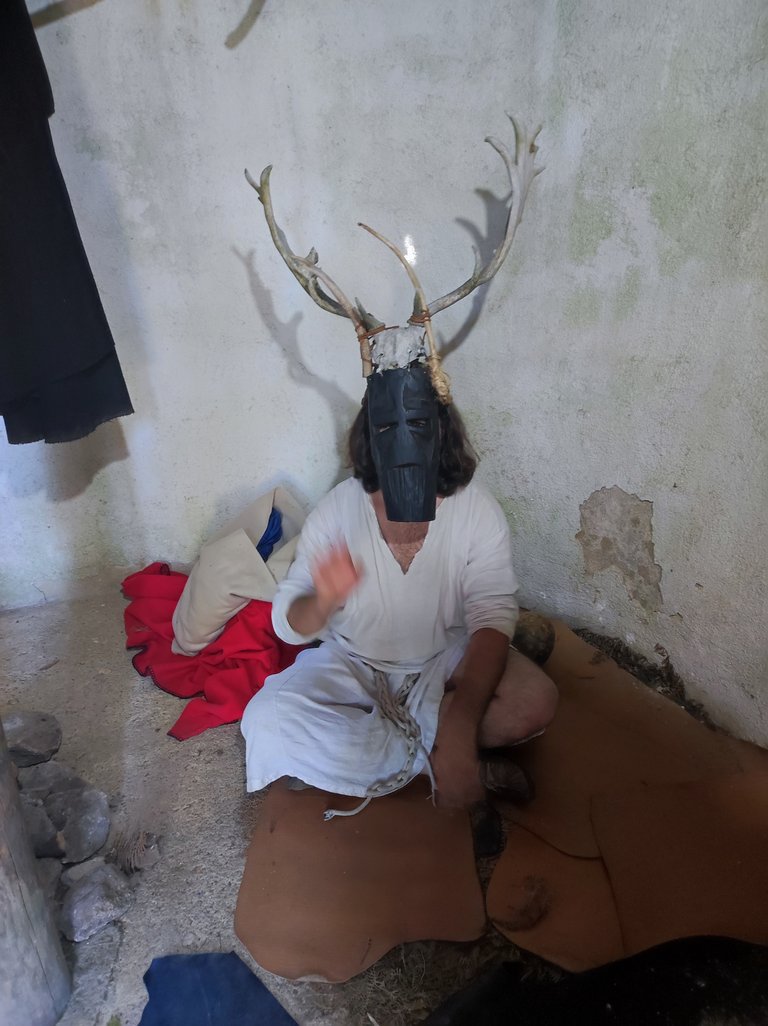Galaicofolia - Portugal
[EN]
Hello, I hope you are well ☺️ Today I bring you the second part of galaicofolia. In this post I will show what I hadn't yet shared, highlighting more incredible moments from this historical recreation in Castro de São Lourenço.

During Galaicofolia, one of the most fascinating attractions was the recreation of the Galaico homes. These dwellings were built with simple materials such as stone and wood and had thatched and straw roofs.

Inside we were able to see the layout of spaces and everyday objects that reveal a lot about life 2000 years ago. The houses were small, but very functional.
The costumes of the galaicos also attracted a lot of attention. They wore linen or linen tunics, which varied in length depending on the season. Men often wore cloaks to protect themselves from the cold, while women adorned their clothing with embroidery. An interesting detail were the horns that some warriors wore, symbolizing strength and courage. These adornments were often used in ceremonies and combat, giving them an imposing appearance.

During the visit, an actor playing a Galician explained in detail various aspects of that time. He told us about the agricultural practices, construction techniques, and religious rituals that were part of daily life. Their passion and knowledge brought to life the history and traditions of the Galician people, providing an educational and engaging experience for all visitors.

He also explained to us that the Galicians were known for their skills in several crafts essential to life in the Iron Age. Agriculture was the main economic activity, with the cultivation of cereals such as wheat and barley, as well as legumes and vegetables. They used rudimentary but practical techniques such as the wooden plow and crop rotation to maintain soil fertility. Animal husbandry, such as sheep, goats and pigs, was also common, providing meat, milk, wool and leather for the community.

Metallurgy was another important activity. The Galatians mastered smelting and working with metals, especially iron and bronze. They produced agricultural tools, weapons and household utensils. The skill of Galician blacksmiths was remarkable and their workshops, generally located in villages, were vital production centers for the local economy. The manufacture of metal ornaments such as brooches and bracelets was also common, reflecting the importance of personal ornamentation and social status

As I said in the previous post, the Galicians were excellent weavers and potters. Women, in particular, were engaged in weaving, creating linen fabrics that were used to make clothes and blankets. Pottery, in turn, was used to produce a variety of household utensils, such as pots, jugs and plates. These objects did not serve daily needs, but were also decorated with geometric and symbolic patterns, demonstrating a refined aesthetic sense and a rich cultural tradition.

I don't know what it's called, but they explained that this is a defensive structure, located at a high point, allowing the Galicians to monitor and protect the village. The castle served as a refuge during attacks and a strategic observation point, essential for defense against invaders. The flag symbolized the tribe's identity and power, reinforcing the community's social cohesion and morale in times of conflict.

The horse-drawn carriages were a spectacle in themselves, representing the means of transport used by the Galicians. Drivers wore traditional attire, with linen or linen tunics, capes to protect against the cold, and leather shoes. The horses were also adorned with fabrics and details that reflected the importance of the event. Chariots were used to transport people and goods, demonstrating the Galicians' ability to domesticate and use animals in their daily activities.

In addition to traditional costumes, the Galicians carried with them various tools and weapons for defense. Among the items, spears, reinforced wooden shields and bronze or iron knives stood out. Warriors wore helmets and light armor, often decorated with tribal symbols to identify their affiliation. These weapons and equipment were essential not only for personal protection, but also for hunting and displays of power during ceremonies and combat. The re-creation of these practices in Galaicofolia offers an authentic glimpse into the life and skills of the Galicians in ancient times.

I hope you liked it, see you soon friends 😊
[PT-BR]
Olá, espero que você esteja bem ☺️ Hoje trago para vocês a segunda parte da galaicofolia. Neste post vou mostrar o que ainda não tinha partilhado, destacando mais momentos incríveis desta recriação histórica no Castro de São Lourenço.

Durante a Galaicofolia, uma das atrações mais fascinantes foi a recriação das casas Galaico. Estas habitações foram construídas com materiais simples como pedra e madeira e tinham telhados de colmo e palha.

No seu interior pudemos ver a disposição dos espaços e objetos do quotidiano que revelam muito sobre a vida de há 2.000 anos. As casas eram pequenas, mas muito funcionais.
Os trajes dos galaicos também atraíram muita atenção. Eles usavam túnicas de linho ou linho, cujo comprimento variava dependendo da estação. Os homens costumavam usar capas para se protegerem do frio, enquanto as mulheres enfeitavam suas roupas com bordados. Um detalhe interessante eram os chifres que alguns guerreiros usavam, simbolizando força e coragem. Esses adornos eram frequentemente usados em cerimônias e combates, conferindo-lhes uma aparência imponente.

Durante a visita, um actor que interpreta um galego explicou detalhadamente vários aspectos daquela época. Ele nos contou sobre as práticas agrícolas, técnicas de construção e rituais religiosos que faziam parte da vida cotidiana. A sua paixão e conhecimento deram vida à história e às tradições do povo galego, proporcionando uma experiência educativa e envolvente a todos os visitantes.

Explicou-nos também que os galegos eram conhecidos pela sua habilidade em diversos ofícios essenciais à vida na Idade do Ferro. A agricultura era a principal actividade económica, com o cultivo de cereais como o trigo e a cevada, bem como de leguminosas e vegetais. Eles usaram técnicas rudimentares, mas práticas, como o arado de madeira e a rotação de culturas para manter a fertilidade do solo. A criação de animais, como ovinos, caprinos e suínos, também era comum, fornecendo carne, leite, lã e couro para a comunidade.

A metalurgia foi outra atividade importante. Os gálatas dominavam a fundição e o trabalho com metais, especialmente ferro e bronze. Produziam ferramentas agrícolas, armas e utensílios domésticos. A habilidade dos ferreiros galegos era notável e as suas oficinas, geralmente localizadas em aldeias, eram centros de produção vitais para a economia local. A fabricação de enfeites de metal como broches e pulseiras também era comum, refletindo a importância da ornamentação pessoal e do status social.

Como disse no post anterior, os galegos eram excelentes tecelões e oleiros. As mulheres, em particular, dedicavam-se à tecelagem, criando tecidos de linho que serviam para fazer roupas e cobertores. A cerâmica, por sua vez, era utilizada para produzir diversos utensílios domésticos, como panelas, jarras e pratos. Estes objetos não serviam às necessidades quotidianas, mas também eram decorados com padrões geométricos e simbólicos, demonstrando um sentido estético apurado e uma rica tradição cultural.

Não sei como se chama, mas explicaram que se trata de uma estrutura defensiva, situada num ponto elevado, que permite aos galegos vigiar e proteger a aldeia. O castelo serviu de refúgio durante ataques e ponto de observação estratégico, essencial para defesa contra invasores. A bandeira simbolizava a identidade e o poder da tribo, reforçando a coesão social e o moral da comunidade em tempos de conflito.

As carruagens puxadas por cavalos eram um espetáculo à parte, representando o meio de transporte utilizado pelos galegos. Os motoristas usavam trajes tradicionais, com túnicas de linho ou linho, capas para proteção do frio e sapatos de couro. Os cavalos também foram enfeitados com tecidos e detalhes que refletiam a importância do evento. Os carros eram utilizados para o transporte de pessoas e mercadorias, demonstrando a capacidade dos galegos em domesticar e utilizar os animais nas suas atividades diárias.

Além dos trajes tradicionais, os galegos carregavam consigo diversos instrumentos e armas de defesa. Entre os itens destacavam-se lanças, escudos reforçados de madeira e facas de bronze ou ferro. Os guerreiros usavam capacetes e armaduras leves, muitas vezes decoradas com símbolos tribais para identificar sua afiliação. Estas armas e equipamentos eram essenciais não só para proteção pessoal, mas também para caça e demonstrações de poder durante cerimônias e combates. A recriação destas práticas na Galaicofolia oferece uma visão autêntica da vida e do saber dos galegos dos tempos antigos.

Espero que tenham gostado, até breve amigos 😊
Congratulations, your post has been added to WorldMapPin! 🎉
Did you know you have your own profile map?
And every post has their own map too!
Want to have your post on the map too?
Obrigado por promover a comunidade Hive-BR em suas postagens.
Vamos seguir fortalecendo a Hive
Your post was manually curated by @Shiftrox.
Delegate your HP to the hive-br.voter account and earn Hive daily!
🔹 Follow our Curation Trail and don't miss voting! 🔹
These are some amazing things to enjoy...the one is to grind the wheat...
True 🙂
Thanks 😊
Sending Love and Ecency Vote!

This place is amazing, I wish I could visit it.
You're really a photographer, hehe. The perspectives you took your shots from are just a clear definition of expertise.
It's an amazing place to be. I have never seen a cart in real life before, this one you showed us is just too beautiful.
True ☺️
Thanks ☺️
Congratulations @name0!
You raised your level and are now a Dolphin!